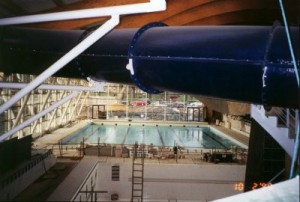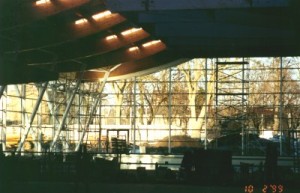Ever wondered what it takes to build a new pool? We went behind the scenes at Cambridge’s new Parkside Pool to find out…
If you’re like me you probably take your pool for granted, turn up and swim, without a second thought for the difficulties involved in getting it there, or indeed how it even got there.


The new Parkside Pool replaced the ageing 33 1/3 pool which dated from the 60’s. To put it bluntly, it was beginning to show its age and was a bit grim. It definitely needed replacing and thanks to the vision of the city council and with a bit of help from the National Lottery in the form of an £8.8million grant, Cambridge now has a pool to be proud of.
But enough of the sales pitch, how did it get there? I hear you cry. Well it’s not easy that’s for sure. The main contractor involved in building it, Wilmott Dixon, had lots of problems. Some of them, such as the glazing or the type of roof, are hardly peculiar to a swimming pool, but just imagine having to build the actual pool tank out of reinforced concrete to within 1mm of 25m as specified by the ASA. This had to include the tiling (which had to be completely flat…) and is no mean feat. If they hadn’t managed it the pool wouldn’t have been able to be used for county or district competitions, let alone events such as the recent 3-nations junior international. So having built your tank and tiled it, how do you know it’s waterproof? You might think that there is a highly advanced and technical method for checking it, but no, the pool was filled up and then watched over a few days to see if it lost any, thankfully it didn’t!
So now we have a building with a pool in it, but it still needs all the equipment for cleaning and supplying the water which is all located underground next to the outside of the pool tank. Having been down to see it, its not a nice place to be, there is nearly a kilometre of pipework taking the water around and all in very confined spaces, which makes getting the filters and ozone machines in a real effort.
The finished product
So was all the effort worthwhile? I certainly think so, the complex boasts an 8 lane deck-level 25m pool, which seems pretty fast as it has a good depth all the way along, with a fully built in Omega timing system and a 4m deep diving pit with a movable floor. Add to this two flumes and a sizeable spectator area, and it’s an excellent multi purpose pool, and a model that others could perhaps learn from.
You’re right to point out Parkside’s good points; however –
1) why on a site that size didn’t they build a 50m pool, which could have been a training and competition pool of international standard? (cost, I expect)
2) why is the pool so perfectly ill-suited to waterpolo, given that at least three clubs play there? It’s much too shallow in the shallow end; that could easily have been altered (just a depth it’s possible to tread water in would have helped)
3)Personally, I would (in a perfect world) have designed a T-shaped pool, with the top bar being the long (50m) dimension, shallow at either end, and the stem being a 25m double deep waterpolo pool – so you could string lane ropes cutting off the top bar to leave a 50m swimming pool and a diving pit; or you could string ropes cutting off the two end pieces, leaving a double deep polo pool and two large shallow areas available for swimming. But that’s just a dream, obviously. (Not mine, either – that’s the design of Blodgett pool at Harvard university – but it’s a beauty.)
Anon.
pullbuoy’s response:
To take your points in turn:
1) Although as you say the site is big enough for a 50m pool, as I understand it, there were very tight planning restrictions in place (the design of the building even had to be approved by the Royal Fine Art commission as it is in Cambridge’s conservation zone). The design couldn’t take up any more space then the previous Parkside pool, and unfortunately a 50m pool simply wouldn’t fit into that footprint. Undoubtedly though as you say the money would not have been available for such a pool anyway!
2) You are correct that the pool is not very well suited to water polo. The council’s aim was a high standard short course swimming pool so I guess as in so many cases water polo was left somewhat out in the cold.
3) I couldn’t agree more! Unfortunately as noted above money and space would have prohibited such a development.
Why the size/shape and unsuitability of CPP for Waterpolo and Long course swimming?
Simply – the ASA and Lottery Sports fund! The conditions of the funding were such that the pool as it stands was pretty much the only result possible in order to qualify for the £7.5 million handout. A 50 metre pool would have been possible in the space, however, as you rightly state the city would have lost the grass land outside. The new pools offer exactly the same water area as the old Parkside Pool
What has resulted is a short course pool that is loved by the people of the city (if not the Councillors themselves – funding has been cut to the Pools despite the success of them, though they are now heavily subsidizing a private pool just 2 miles away!) and by swimmers and swimming officials all over the country – hence hosting the Midland District Short Course Championships 3 years running, National Diving Championships, and a 3 Nation International!
Not many pools can offer such a high quality of build, or level of customer service – this becomes evident when you look at the number of customers the pools have each year (in year 1 there were over 650,000 swimmers compared with an estimate of 300,000 and the old Parkside’s 150,000!)
Hugh Green
